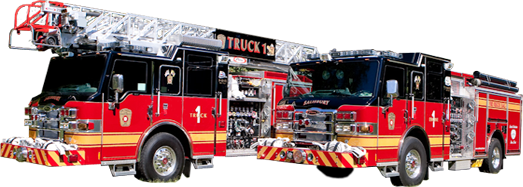Photo Gallery
The History Behind Fire Prevention Week
Friday, October 4, 2019
The History Behind Fire Prevention Week
Fire Prevention Week was established to commemorate the Great Chicago Fire, the tragic 1871 conflagration that killed more than 250 people, left 100,000 homeless, destroyed more than 17,400 structures and burned more than 2,000 acres. The fire began on October 8, but continued into and did most of its damage on October 9, 1871.
According to popular legend, the fire broke out after a cow - belonging to Mrs. Catherine O'Leary - kicked over a lamp, setting first the barn, then the whole city on fire. Chances are you've heard some version of this story yourself; people have been blaming the Great Chicago Fire on the cow and Mrs. O'Leary, for more than 130 years. But recent research by Chicago historian Robert Cromie has helped to debunk this version of events.
Like any good story, the 'case of the cow' has some truth to it. The great fire almost certainly started near the barn where Mrs. O'Leary kept her five milking cows. But there is no proof that O'Leary was in the barn when the fire broke out - or that a jumpy cow sparked the blaze. Mrs. O'Leary herself swore that she'd been in bed early that night, and that the cows were also tucked in for the evening.
Over the years, journalists and historians have offered plenty of theories. Some blamed the blaze on a couple of neighborhood boys who were near the barn sneaking cigarettes. Others believed that a neighbor of the O'Leary's may have started the fire. Some people have speculated that a fiery meteorite may have fallen to earth on October 8, starting several fires that day - in Michigan and Wisconsin, as well as in Chicago.
Those who survived the Chicago fire never forgot what they'd been through; the blaze produced countless tales of bravery and heroism. But the fires also changed the way that firefighters and public officials thought about fire safety. On the 40th anniversary of the Great Chicago Fire, the Fire Marshals Association of North America (today known as the International Fire Marshals Association), decided that the anniversary of the Great Chicago Fire should henceforth be observed not with festivities, but in a way that would keep the public informed about the importance of fire prevention. The commemoration grew incrementally official over the years.
What is often forgotten is that at the same time the Chicago fire was taking place, and even more deadly fire in the northeastern corner of Wisconsin was also occurring. The Peshtigo fire burned approximately 1,200,000 acres and to this day is the deadliest wildfire in American history claiming over 1,200 lives. The Peshtigo fire usually receives little recognition outside the region because the Chicago fire captured all the headlines. The Peshtigo fire is believed to have been caused by railway workers clearing land for tracks and the estimated cost of the fire was approximately $169 million, or approximately the same as the Chicago fire.
In 1920, President Woodrow Wilson issued the first National Fire Prevention Day proclamation, and since 1922, Fire Prevention Week has been observed on the Sunday through Saturday period in which October 9 falls. According to the National Archives and Records Administration's Library Information Center, Fire Prevention Week is the longest running public health and safety observance on record. The President of the United States has signed a proclamation proclaiming a national observance during that week every year since 1925 when President Calvin Coolidge proclaimed Fire Prevention Week a national observance.
This year’s fire prevention theme is “Not all heroes wear capes. Plan and practice your escape.” The Salisbury Fire Department urges you to check you smoke alarms monthly, maintain good housekeeping principles, do not overload electrical outlets, develop and practice escape plans that encompass two ways out of every room in your home (at least twice per year), and teach children and the elderly methods of self-escape in the event no one is able to get to them in the event of a fire.
For more information visit: https://www.nfpa.org/Public-Education/Staying-safe/Preparedness/Fire-Prevention-Week/About or https://www.weather.gov/grb/peshtigofire






